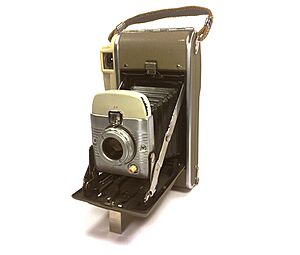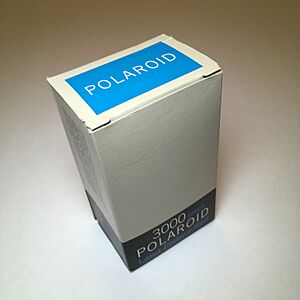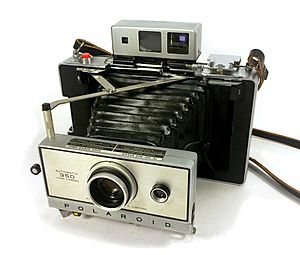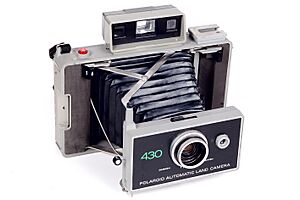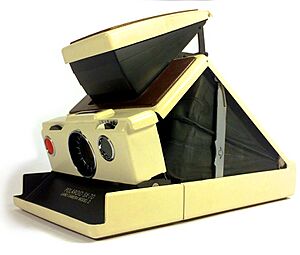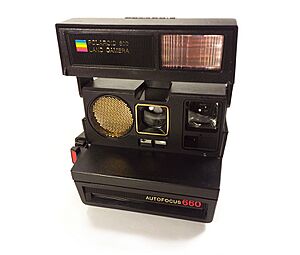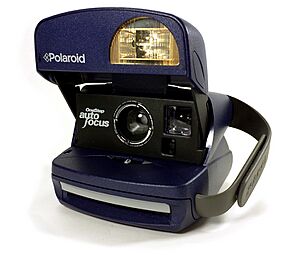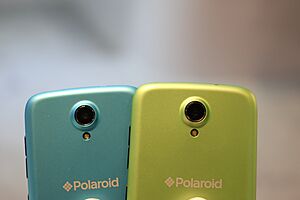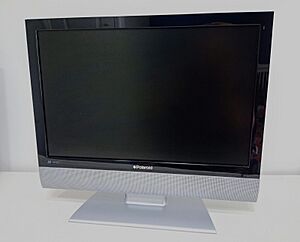Polaroid Corporation facts for kids
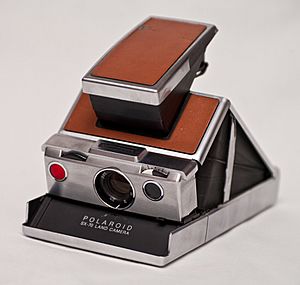
The Polaroid SX-70, manufactured by Polaroid Corporation from 1972 to 1981
|
|
| Private | |
| Industry | |
| Fate | Bankruptcy And Liquidation; Brand sold to One Equity Partners; changed name to Primary PDC, Inc. |
| Successor | Polaroid B.V. |
| Founded | 1937, in Cambridge, Massachusetts, U.S. |
| Founder | Edwin H. Land |
| Defunct | 2002 |
| Headquarters | Minnetonka, Minnesota, U.S. |
|
Area served
|
Worldwide |
| Products |
|
|
Number of employees
|
21,000 (1978) |
Polaroid Corporation was a famous American company. They made special cameras and film that could print pictures instantly! Today, Polaroid is still a well-known brand for electronics.
It was started in 1937 by a clever inventor named Edwin H. Land. He used his invention, a special material called a 'polarizer,' to create new products. Edwin Land and Polaroid made the very first instant camera, called the Land Camera, in 1948.
Mr. Land led the company for many years, until 1981. At its busiest, in 1978, Polaroid had 21,000 employees. The company's sales reached $3 billion in 1991.
Polaroid Corporation faced financial trouble and declared bankruptcy in 2001. Its brand name and other valuable parts were sold off. A new company eventually took over the Polaroid brand. The brand changed hands a few times before being bought by a Polish investor in 2017. This led to a company called Impossible Project, which made film for old Polaroid cameras, changing its name to Polaroid Originals in 2017. Later, in 2020, it became simply Polaroid. Since the original company closed, many other companies have made products like LCD televisions and DVD players under the Polaroid name.
Contents
The Start of Polaroid
How Polaroid Began
The first Polaroid Corporation was founded in Cambridge, Massachusetts, in 1937. Edwin Land and George W. Wheelwright III started it. People called Polaroid a "juggernaut of innovation." It was like the "Apple of its time." Edwin Land, a scientist, led the company as CEO for 40 years.
Polaroid first sold polarized sunglasses. This idea came from Land's own research into how light behaves. Land left Harvard University after his first year to work on this idea. He later returned to Harvard to continue his studies.
Polaroid owned patents for its special polarizer technology. They used this technology in products like 3-D movies and special goggles for military dogs. During World War II, Polaroid made many products for the armed forces. This included a device that helped people see at night using infrared light.
Edwin Land is known as the father of instant photography. He put all the steps of developing a photo right inside the film itself. He first showed his new Land Camera to the public in February 1947. For many years, users had to pull a tab and peel the picture. But in 1972, the SX-70 camera came out. It automatically ejected the printed picture. Life magazine featured Land on its cover in 1972. The caption called him "A Genius and His Magic Camera."
In the 1940s, Polaroid bought a building in Cambridge, Massachusetts, for its main office. This building was famous for its modern design. It was added to the list of historic places in 1982.
The Lawsuit with Kodak
In 1976, another company called Kodak announced its own instant film cameras. Polaroid quickly sued Kodak. They said Kodak had copied their patented instant photography process.
Over the next two years, sales of instant cameras grew a lot. The lawsuit in federal court lasted for 10 years. Polaroid asked for a large amount of money from Kodak. The court decided that Kodak had copied Polaroid's patents. Kodak was told to stop making instant pictures. They also had to pay Polaroid a large sum of money.
Challenges and Changes
Polaroid's Decline
In 1977, Edwin Land introduced a new product called Polavision. It was an instant home movie camera. However, at that time, video systems using videotapes were becoming very popular. Polavision did not sell well. Some people saw it as the last big invention from Polaroid.
After leading the company for four decades, Edwin Land was asked to step down. He left the company he had started. He passed away in 1991. The Polavision project caused the company to lose a lot of money.
William J. McCune Jr. became the chief executive officer in 1980. He had joined Polaroid in 1939. He led the company until 1985.
In the 1980s, Polaroid tried to change. They wanted to rely less on consumer photography. This market was starting to shrink. In 1984, Polaroid announced they would start selling their own line of videotapes.
Polaroid had to make big changes. They had to let go of many workers and close factories. New technologies were changing photography. These included one-hour photo developing, disposable cameras, and video camcorders. In the 1990s and 2000s, digital cameras became popular.
Polaroid was actually one of the first companies to make digital cameras. They released the PDC-2000 in 1996. But they did not sell many digital cameras.
Before its financial troubles, the company sold its historic headquarters building.
Bankruptcy and New Beginnings
The original Polaroid Corporation filed for bankruptcy on October 11, 2001. This meant they needed help to manage their debts. Within ten months, most of the business was sold. This included the "Polaroid" name itself. A company called One Equity Partners bought these parts. This new company then used the name Polaroid Corporation.
There was some criticism about this sale. Company executives received large bonuses. However, many stockholders and employees were left with nothing.
The original Polaroid Corporation changed its name to Primary PDC, Inc. It no longer did business. Many people believe Polaroid's financial problems happened because its leaders did not see how digital cameras would affect their film business.
The Polaroid Brand Today
After the bankruptcy, the Polaroid brand name was used for other products. Companies were allowed to make and sell items like digital cameras under the Polaroid name. Polaroid-branded LCDs, plasma televisions, and portable DVD players also appeared.
In 2005, a company called Petters Group Worldwide bought the Polaroid Holding Company. This company often bought failed brands. In the same year, another company bought Polaroid's factories. Most manufacturing then moved to China. Polaroid stopped making its cameras in 2007. They stopped selling Polaroid film after 2009.
In 2008, the company that owned Polaroid at the time also filed for bankruptcy. This happened after problems with its parent company.
New Owners for Polaroid
In 2009, a company called Patriarch Partners won an auction for Polaroid's assets. This included the company's name and its collection of photographs. However, there were legal disagreements. Eventually, a joint venture between Gordon Brothers Brands and Hilco Consumer Capital took over.
This new group formed a parent company called PLR IP Holdings, LLC. Scott W. Hardy became the new president of Polaroid. Most employees stayed in their jobs.
In 2009, PLR IP Holdings announced a deal with Summit Global Group. This company would make and sell Polaroid-branded digital cameras and other mobile products.
In 2010, the famous singer Lady Gaga was named "Creative Director" for Polaroid. She was the "new face" of the company for a while.
Polaroid's Comeback: 2017 to Today
In 2017, a Polish investor named Wiaczesław "Slava" Smołokowski bought PLR IP Holdings, LLC. He was already a major investor in the Impossible Project. This company had started making film for old Polaroid cameras after Polaroid stopped. This purchase brought both companies under the same ownership.
The Impossible Project then changed its name to Polaroid Originals. The factory in the Netherlands that made the film also took on the new name.
By 2019, the new polaroid.com website showed instant cameras and film from Polaroid Originals. It also showed other products like digital cameras, sunglasses, and televisions.
In March 2020, Polaroid Originals changed its name again to simply Polaroid. The Polaroid Now was the first instant film camera in years to have the main Polaroid branding.
Keeping Old Polaroid Cameras Alive
Today, companies like Polaroid B.V. and MiNT Camera fix and restore classic Polaroid cameras. Some companies even change the cameras to add new features. For example, some Polaroid SX-70 cameras can be changed to use the more common Polaroid 600 film.
Other Polaroid Products
Floppy Disks
In 1985, Polaroid also had its own brand of floppy disks. These were used to store computer data. They even offered a service to recover lost data from disks. By 1991, Polaroid stopped selling floppy disks.
Sports Sponsorships
In the 1990s, Polaroid sponsored NASCAR races. They were a main sponsor for some races, like the "Polaroid 125." The Polaroid name was also seen in other NASCAR series. For example, Polaroid sponsored female NASCAR driver Shawna Robinson's car for several years.
Polaroid also sponsored cars in the IndyCar Series. The Polaroid name was also linked to the NOPI drift series.
Bringing Back Polaroid Film
On February 8, 2008, Polaroid announced they would stop making instant film products. But since March 2010, new instant film has been available for old Polaroid cameras. This film is made by a group called The Impossible Project. They use the old Polaroid factory in the Netherlands.
A photographer named Florian Kaps bought the remaining film packages. He worked with André Bosman, a former head of film production at Polaroid. They planned to redesign the film system. They convinced the Polaroid owners to help. Plans for a relaunch under the Impossible label were announced in 2009.
In 2010, Impossible released two black and white films. These worked with SX-70 and 600 type cameras. Color films followed in 2010 and 2011.
Impossible also released new cameras. In 2016, they released the Impossible I-1. In 2017, after rebranding to Polaroid Originals, they released the OneStep 2. This camera looked like the original Polaroid OneStep but had new features.
In 2012, a documentary called "Time Zero: The Last Year of Polaroid Film" was released. It showed how Polaroid's instant film technology rose, fell, and then came back.
Mobile Printers
In 2008, Polaroid released the PoGo. This was a small printer that made instant photos. It used special "zero ink" technology. The dye was already in the photo paper.
In 2009, a PoGo camera was released. It was a 5-megapixel digital camera with a built-in printer.
In 2011, the company released the Polaroid GL10 Instant Mobile Printer. This printer was designed by Polaroid and Lady Gaga. It allowed people to print directly from their phones or digital cameras.
Digital Photography
Polaroid also made digital cameras without printers. One example was the t1035, a 10-megapixel digital camera.
In 2012, Polaroid announced a new "smart camera" called the Polaroid SC1630. It ran on Google Android. This camera was like a mix of a camera and a portable media player. Users could take photos, download apps, check email, and browse the web. It had a 16 MP camera with optical zoom. It also had Wi-Fi and a touch screen.
In 2014, Polaroid introduced a small action camera called the "Polaroid Cube." It was a cheaper option compared to other action cameras.
Images for kids
See also
- List of Polaroid instant cameras
- Polacolor
- Polaroid (polarizer) – a light-polarizing material developed by Edwin H. Land
- Polaroid Eyewear
- Zink (technology)



